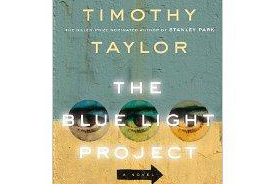Two things are happening right now that have an intense and resonant connection.
- The Blue Light Project is published in paperback at the same time as being selected as a contestant for a reality-television-styled vote-based Bookie Award.
- The Red Gate artists’ collective has found a potential new home, but needs City of Vancouver approval to move in as the City owns the property.
The connection is forged by my knowledge that The Blue Light Project might never have been written were it not for the Red Gate.

This is the piece of art that started my whole creative process.
It’s called Rise Fly Land and the day I first saw it, I stood in that alley for a good twenty minutes staring at it. At that point in my exposure to graff and street art, I didn’t know enough to recognize that signature at the bottom, which is that of the legendary Canadian graff writer (and almost equally legendary train-rider) Take5. All I knew was that there was something mysterious and entire in the image. Rise. Fly. Land. There is a echo of eternity in the phrase. A bass note of wisdom, of peace.
I had only very recently seen Les Blank’s oddly captivating film Werner Herzog Eats his Shoe in which Herzog makes the following slightly enigmatic statement: “We need adequate images. If mankind doesn’t develop adequate images, we’re going to die out like the dinosaurs.”
Somehow standing in that alley off Hastings Street, I felt like I was confronted with an authentic attempt at an adequate image. It was a moment both warming and chilling, if that makes any sense.
Of course, like I said, I had no idea who had made the piece. Until I talked to Jim Carrico at the Red Gate, that is. And he introduced me to Take5 who then told me that he and the artist OTHER had made Rise Fly Land. Take5 also gave me my first glimpse into the world of the street artist in a long and fascinating conversation in the original Red Gate location. From there, literally branching out from the Red Gate and into this hidden community of artists, my interest in the area and my ideas for the book began to surge and take shape.
The Red Gate always was a chaotic place, with no particular central plan or manifesto. But it was from that environment that came the sparks of original idea.
When the Red Gate was threatened with shut-down last year, I lamented the prospect in a Vancouver Review essay called Chaos and Planning. In that piece I argued that the Red Gate was the source of creative chaos that all cities need. Kill these sorts of institutions – out of some hyper-vigilant sense that everything has to be planned centrally in coordination with official messages – and you kill the organic creativity on which all cities depend.
My article didn’t help. The Red Gate lost it’s fight and were evicted. It was a real loss to the city.
Now we come to another turn in the story. The Red Gate has a chance to reopen. The building they want to use is empty. They’re willing to pay rent. And the whole situation is in the hands of the City of Vancouver, as they own the building.
Is it possible that our civic leaders will miss for a second time the contribution that the Red Gates of this world make to the cities where they’re found?
On the cover of the paperback Blue Light are three eyes, by the artist Rich S. For awhile prior to the Olympics in Vancouver, these could be found widely through the downtown east side. I loved those eyes. What a lot they managed to say in one image about the hovering reality, good and ill, of our governments and leaders.
What will our leaders in Vancouver do now?

